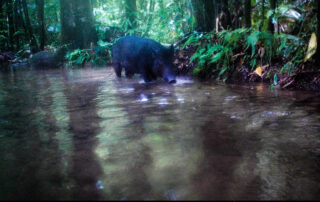Camera Traps across February 2021 accrued 111-cassowaries, 16-dingoes and 276-feral pigs. Against the cumulative monthly average, cassowary numbers were 150% up, dingoes were 43% down and feral-pigs were 195% up. Against February 2020, cassowaries were 12%-down, dingo numbers were 533% higher and feral-pigs had also increased by 150%.
Image highlights from February
Upon reflection, February 2020 had the highest cassowary numbers of the year (75) and overwhelmingly from camera trap #3. The next highest had fewer than a third the number of cassowary sightings. This February, the same camera trap peaked with 74 cassowary sightings, only one-less than the year before, but the next highest contender accrued only 14 cassowary sightings.
Camera trap #3 sits about 70-metres away from our dwelling and about 30-metres from the edge of Cooper Creek, squarely in there heart of Big Bertha’s core territory. After a remarkably depauperate 2020, in terms of cassowary reproduction, BB resumed reproductive behaviour towards the middle of January. This is made abundantly clear by the convergence of competing males and the high-intensity courtship behaviour. Female cassowaries are substantially larger and heavier than males and are clearly the dominant gender. Nevertheless, males must distinguish their genetic prowess against all contenders, through bravery and evasion. A courting male typically vocalises, in a manner not dissimilar to the woofing of a dog, as it strides just short of running towards the female. Most male approaches towards BB come from crossing Cooper Creek towards our dwelling and as BB responds to both the vocalisation and the aggression of the approaching male, she elevates her torso into the full height of her formidable stature. She walks authoritatively toward the male, whose pace subtly reduces and as the distance between the two diminishes, so does the male begin to deviate from his line of approach, first slowly, but he soon accelerates the rate of deviation into a u-turn as he runs for dear life. Big Bertha is hot on his tail, with his posterior plumage fluffed up as if signalling a last expression of genetic flair. These vocal charges and retreats continue through the following days and weeks, until finally, undoubtedly based on which male distinguishes itself as the bravest and most evasive, is permitted to mate with the female.
As of 27 April 2016, Daintree Rainforest Foundation Ltd and its Daintree Rainforest Fund have been registered by the Australian Charities and Not-for-profits Commission and also successfully entered onto the Register of Environmental Organisations.
Donations made to the public fund are eligible for a tax deduction under the Income Tax Assessment Act 1997.














